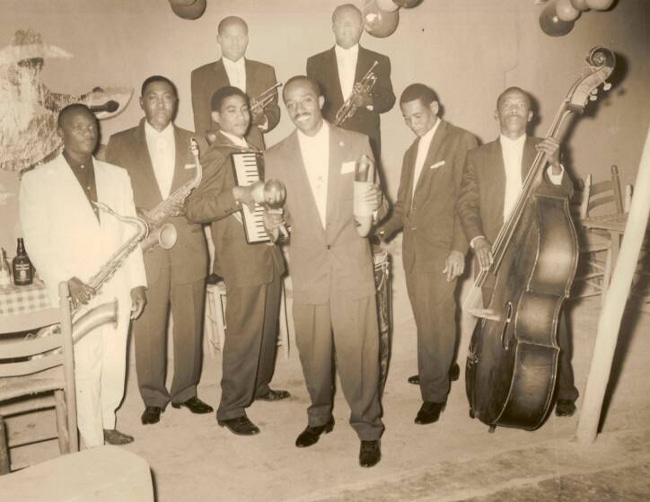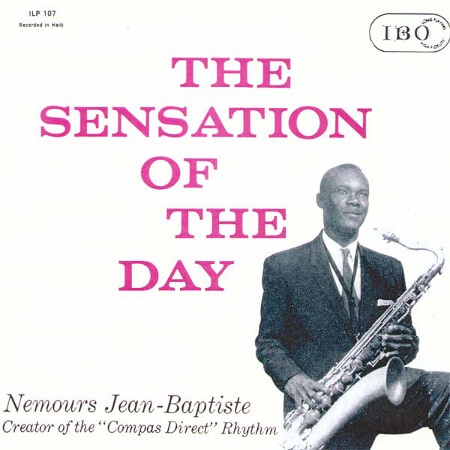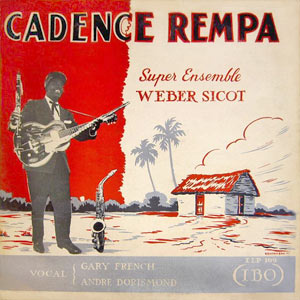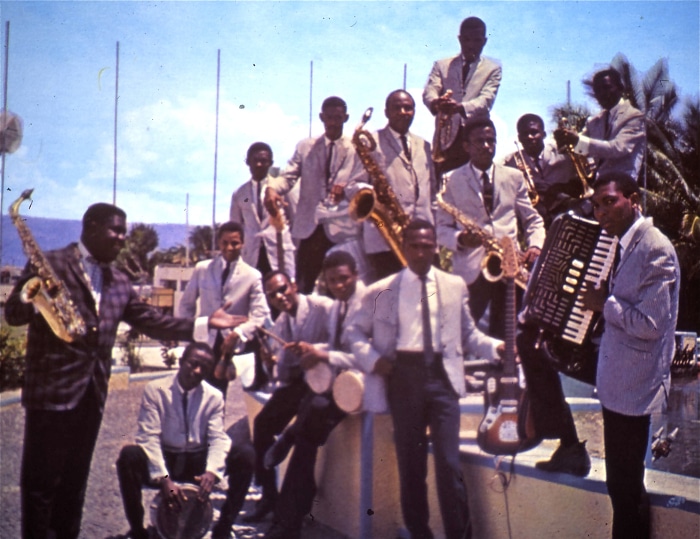Konpa! Popular music in Haiti

The origins of Konpa and Kadans
In the mid-1950s, Haiti's cities, particularly Port-au-Prince, were home to a thriving music scene concentrated in hotels and nightclubs. This scene became more popular with the development of a network of radio stations throughout Haiti, and to a lesser extent with the burgeoning record industry. Haiti is also a regular destination for Caribbean musicians touring the region, as well as a number of American jazzmen.
The Dominican influence
In neighbouring Dominica, merengue (a cousin of the Haitian meringue) achieved unprecedented popularity, thanks in part to the support of President Rafael Trujillo. It became popular in Haiti with recordings and the arrival of groups on tour. Dominican radio stations were also picked up in Haiti, particularly La Voz Dominicana (owned by Trujillo).
Many Haitian musicians grew up listening to the merengue cibaeño (the oldest form of merengue) of Nico Lora and Angel Viloria... or the big band merengue of Luis Alberti and Lira des Yaqui. Lira des Yaqui came to Port-au-Prince in 1955, but it was with the 1954 tour by Viloria and his group Tipico Cibaeño that Haiti really succumbed to the merengue wave. The genre was particularly popular among Dominican prostitutes in Haiti, who taught Haitian men how to dance it in dance halls concentrated for the most part in the commune of Carrefour.
And in the summer of 1955, right in the middle of the Dominican merengue craze, Nemours Jean-Baptiste launched his new Dominican-influenced dance at the club Aux Palmistes, where he conducted the orchestra.
Nemours Jean-Baptiste and konpa-dirèk
Nemours Jean-Baptiste was born into a middle-class family in Port-au-Prince on 2 February 1918. He learnt guitar and banjo with Barrato Destinoble in Les Cayes. In Port-au-Prince, he took saxophone lessons with Victor Flambert.
In the early 1940s, he joined Jazz Guignard and Conjunto International, where he later met his future partner and rival Wébert Sicot. Nemours was one of the stars of the Trio (later Orchestre) Atomique, named after its lead singer Djo Atomique (real name José Laveau). Of Dominican and Haitian origin, he specialises in Cuban and Dominican repertoire.
Around 1952, Nemours left the Orchestre Atomique. In 1953, he founded his own orchestra at the club Aux Calebasses. Raymond Gaspard, Nemours' guitarist, coined the term compas-direct (konpa-dirèk in Creole, later reduced to konpa). This commercial label associated with the group's new sound roughly means "straight, square (rhythmic) beat".
The Ensemble Aux Calebasses de Nemours Jean-Baptiste in 1957 in what is considered to be the third version of the Nemours orchestra, when it was still performing at the Aux Calebasses discotheque.
Nemours is in a white suit on the left. Singer Julien Paul is in the centre with the maracas. Beside him are Richard Duroseau on accordion and Ketzer Duroseau on drum. Augustin Fontaine is on the right on double bass.

Characteristics of konpa-dirèk
The 'square' rhythmic pulse that characterises konpa is reinforced by the 'one-two' rhythm of the double bass, over which the drum plays a variant of the Dominican merengue (traditionally played on the bi-membranophone tambora). The accordion plays chords and arpeggios (patterns played on the notes of the chord) as well as a few melodic passages. Saxophones and trumpets play the main melodic lines in response.
Konpa-dirèk was the first Haitian music to evolve in a completely commercial environment. In its early years, it faced much criticism from cultural nationalists, for its popular orientation, its Dominican influences, and for what they saw as a purely commercial innovation.
While the urban middle class is the core audience for konpa music, Nemours strives to diversify it. On Friday evenings, he plays for teenagers in urban areas, on Saturday evenings for the elite at Cabane Choucoune in Pétion-Ville, on Sundays for the middle classes at Aux Calebasses or Sous Les Palmistes, at Carnaval for the working classes, and finally in the provinces during fèt patwonal (saint's festivals) and other fèt chanpèt (farmers' festivals).
Cover of the Ensemble Nemours Jean-Baptiste album released by Ibo Records in 1961, featuring singers Louis Lahens and Jean-Claude Félix.

Controversy surrounding konpa
Competing with konpa-dirèk, the Jazz des Jeunes orchestra, on the strength of its status as Haiti's leading orchestra, openly criticised the new fashion and the orchestra that launched it, in a series of insulting songs in the form of a musical duel. These songs take the form of veritable chan pwen (a form of belittling and criticism sung, including targeted allusions but rarely mentioning the addressee, common in Vodou and rara processions).
Jazz des Jeunes describes the Nemours group as comic monkeys with no (cultural) memory who can only sing three three words and play a single (imported) rhythm, all in a single key! They invoke the image of the fearsome Vodou deity Baron Samedi, who will judge them in the cemetery for insulting their ancestors!
But this was without taking into account the immense wave of popularity for konpa, which was already on the rise. In 1958, during a concert at the Palladium discotheque (in Carrefour), Nemours renamed his group the Ensemble Nemours Jean-Baptiste (then, in 1963, the Super Ensemble Nemours Jean-Baptiste). By this time, konpa-direk was the most popular style in Haiti, and on the verge of becoming the country's new national dance. Nemours Jean-Baptiste was known to say: Dépi ou konn maké pa, ou toujou sou konpa (As soon as you can walk, you're always in konpa (in the groove)).
Wébert Sicot and the kadans-ranpa
Wébert Sicot was probably the most important Haitian saxophonist of his time. He started out in the band Le Jazz Capois, with his trumpeter brother Raymond. He played with some of the greatest orchestras of the late 1940s and 1950s, including Conjunto International, Orchestre Atomique, Ensemble de la Cabane Choucoune and Ensemble Aux Calebasses de Nemours.
Around 1959, Sicot formed the Webert Sicot Ensemble and created a new dance rhythm that was barely distinguishable from Nemours' konpa-dirèk. He called it cadence rempa, but record producer Joe Anson creolised it as kadans-ranpa. Kadans means rhythm andranpa remparts, a reminder of the warlike relationship between the two rival groups.
They imitate each other, insult each other regularly, each trying to outdo the other, and sometimes even steal each other's equipment.

Cover of the third album by the (Super) Ensemble Weber Sicot, released on Ibo Records in 1961, featuring Gary French and André Dorismond.
The controversy took musical form with a series of mocking songs. Nemours evokes the rivalry in the song "Rythme commercial", which depicts Nemours as a mango tree full of fruit on which stones are thrown (according to the Haitian proverb, "On ne jette des pierres que sur des manguiers plein de fruits"):
The "three dangers" evoked by the title of this Nemours album released in 1965 are : Nemours Jean-Baptiste, Richard Duroseau (accordion) and Raymond Gaspard (guitar). The band's previous hit albums are on display in the background.
Sicot, widely regarded as the best musician, retorted by insulting Nemours' musicality in the song "Deux guidons" (Two standards):
The two leaders would admit that the controversy had a marketing function, increasing the level of support and interest of their respective fans. In 1964, the Nemours and Sicot groups went so far as to play a football match at the Stade Sylvio Cator in front of 35,000 fans, which ended in a 1-1 draw. And of course, each group sang its own version of the match!
The musical duels of this period had a strong influence on Haitian popular music. Over the next 60 years, a growing number of rival pairings would emerge.
Konpa, carnival and koudyay
At the carnival in the early 1960s, the two rival groups polarised the country's attention. The participation of the new konpa-direk and kadans-ranpa groups in the carnival symbolised the growing importance of the middle class in the country's political affairs.
Huge crowds gather around their favourite band, set up on towed floats or lorries and playing music amplified by large speakers, which drowns out the acoustic music of the foot bands.
At the carnival, Nemours and Sicot fans regularly clash. Supporters can be identified by the colours they wear. Even Duvalier's militia, the tonton macouts, are divided on the subject, wearing the colours of one group or the other over their denim uniforms. The Nemours and Sicot parades were each led by leading makouts. The children of 'Papa Doc' (François Duvalier) were also at loggerheads, with Jean-Claude in favour of Sicot's kadans-ranpa and his sister Denise in favour of Nemours' konpa-direk.
The lively konpa carnival songs celebrate the election of 'Papa Doc' for life, the construction of a new airport, and the creation of a new dam to put an end to the blakawout (from 'blackout').
Despite sporadic efforts to quell the controversy, Nemours and Sicot waged a musical war throughout the 1960s.
The two groups composed and performed songs in support of the Duvalier government, which politically hijacked the koudyay. The koudyay is a form of exuberant celebration organised by the powerful and held in the streets. The organiser provides drinks, food, music, the theme of the koudyay and, if necessary, transport. The event was an opportunity for the poorer classes to have fun on the cheap, and for the organiser, through the mass mobilisation, to give the impression of broad popular support. Duvalier orchestrated carnival and koudyay for political ends, to divert popular attention from social and economic problems and to exploit the populist passions of the pro-Duvalier and anti-elite masses. Whether for spontaneous koudyays, for the July festivities known as the "Carnival of Flowers", or for carnival, musicians were hired (forced) to play and pledge their allegiance to the dictatorship.

Photo of the Webert Sicot Ensemble taken from the cover of the 1967 album "La Flèche d'Or d'Haïti" (the group's nickname).
The years 1967-68 marked the end of the era of musical domination by the two rival groups (Nemours VS Sicot).
Throughout the 1960s, the main orchestras of the earlier period (Jazz des Jeunes, Tropicana, Septentrionale, Raoul Guillaume and his group, etc.) continued to perform and record albums.
Haitian music from the late 1950s to the late 1960s was profoundly shaped and dominated by the two heavyweights, the Nemours and Sicot orchestras, to such an extent that the period is known as "épok Nemou ak Siko" or "épòk polémik".
But from the late 1960s onwards, mini-djaz (smaller orchestras) began to monopolise young audiences.
"The embrace
In the 1980s, the modest financial situation of Nemours and Sicot led to an awakening among Haitian musicians and fans to reward and better honour musicians, to respect the history of the country's popular music, and even to put an end to the tendency towards musical polemics; this movement was later called "l'accolade".
In 1977, producer Fred Paul (of the Mini Records label) and his label's orchestra, the Mini All-Stars, released the album "Gina", featuring music by Webert Sicot. And in 1980, Tabou Combo released "Hommage à Nemours Jean-Baptiste":
That same year, a party was organised in New York to celebrate the 25th anniversary of konpa-dirèk. The organisation brought Nemours from Haiti to play with members of Skah Shah. During the evening, money will be raised to buy him a new saxophone. There was also talk of helping him to set up and conduct a new orchestra. Sadly, he died shortly afterwards!


